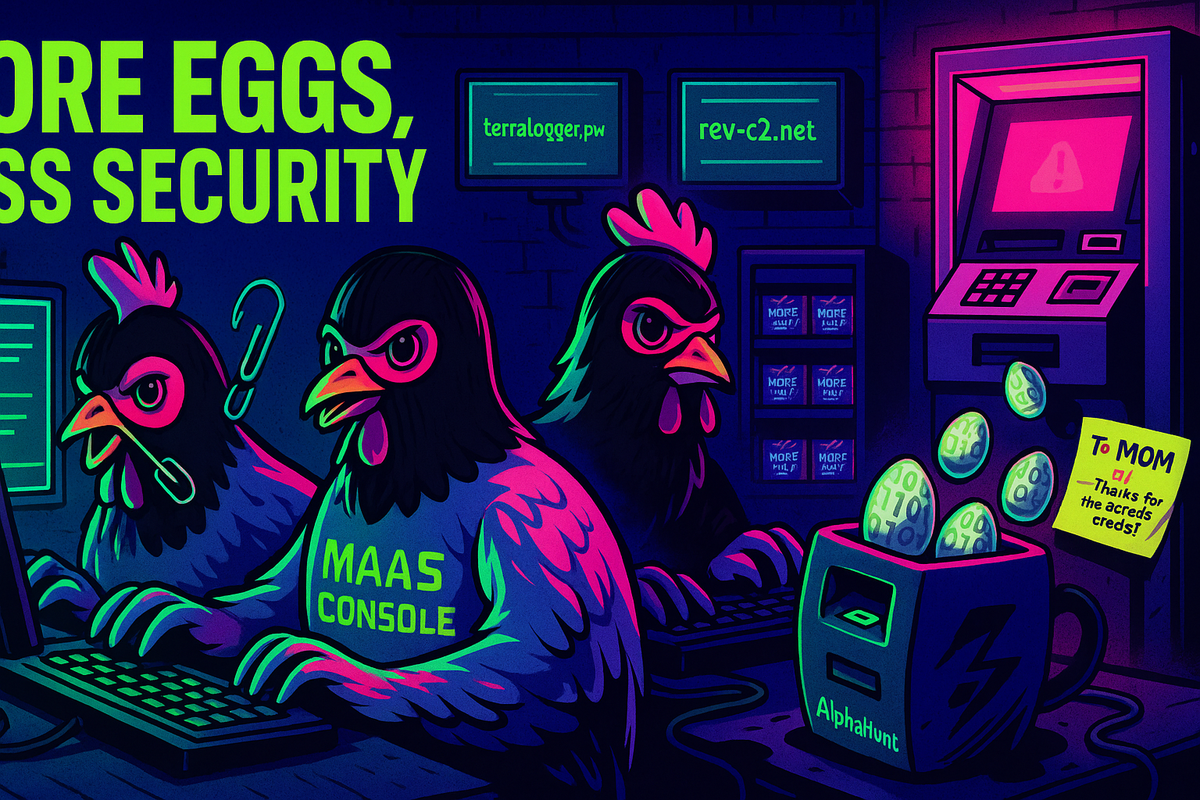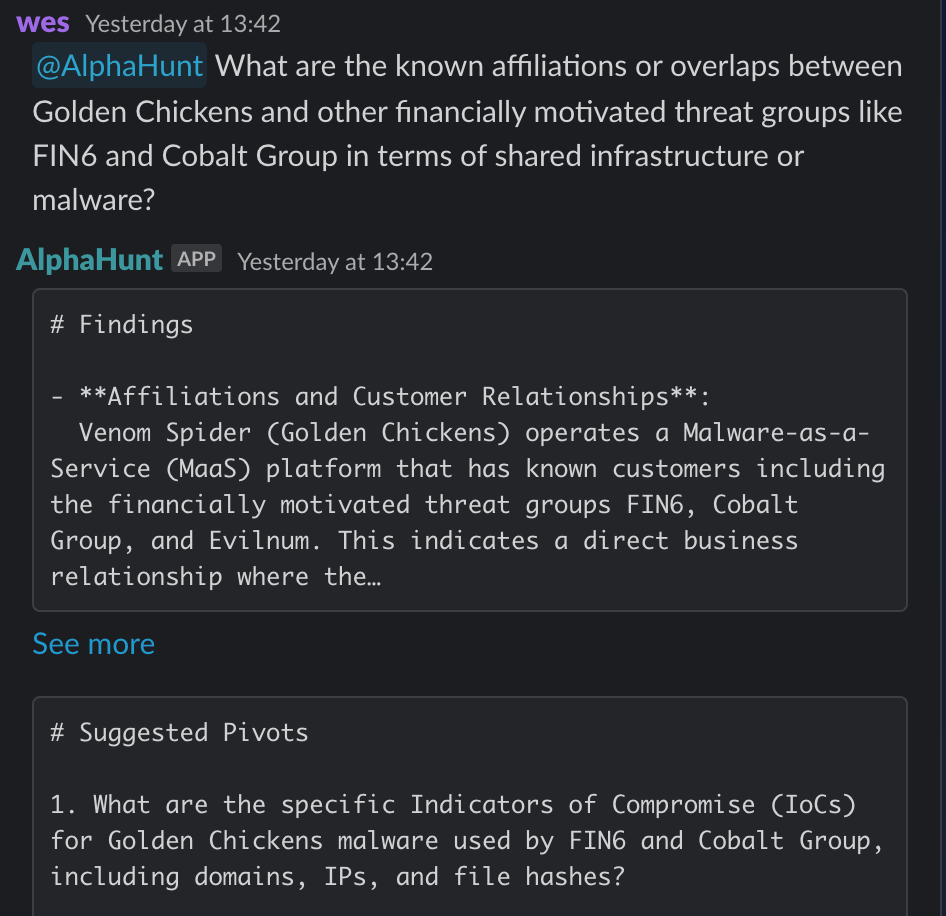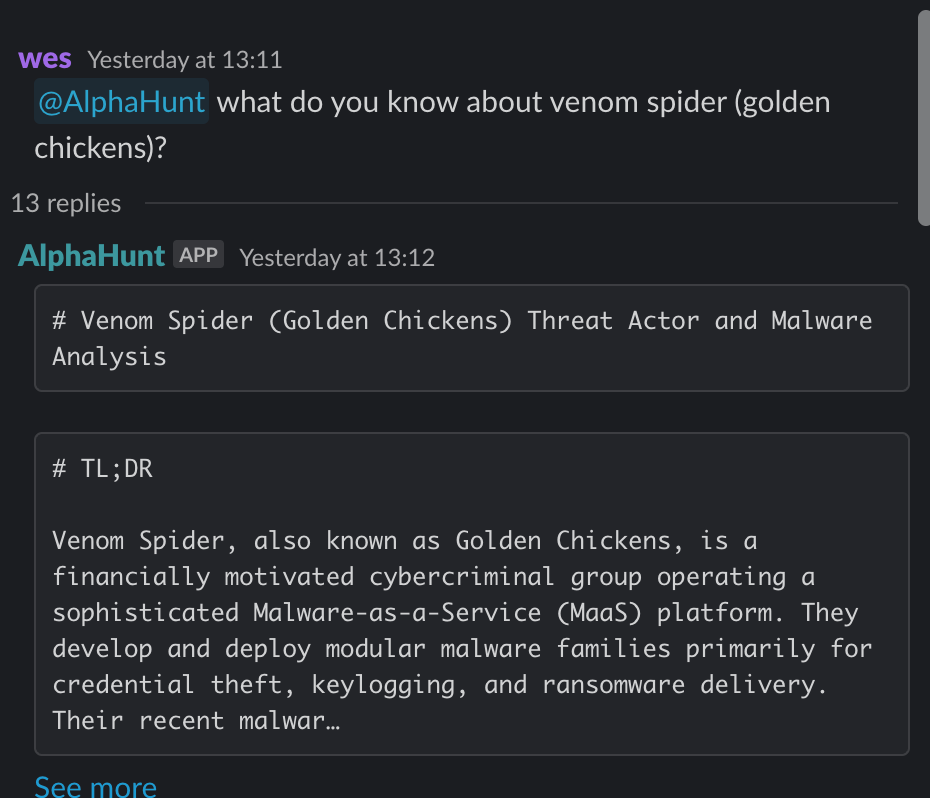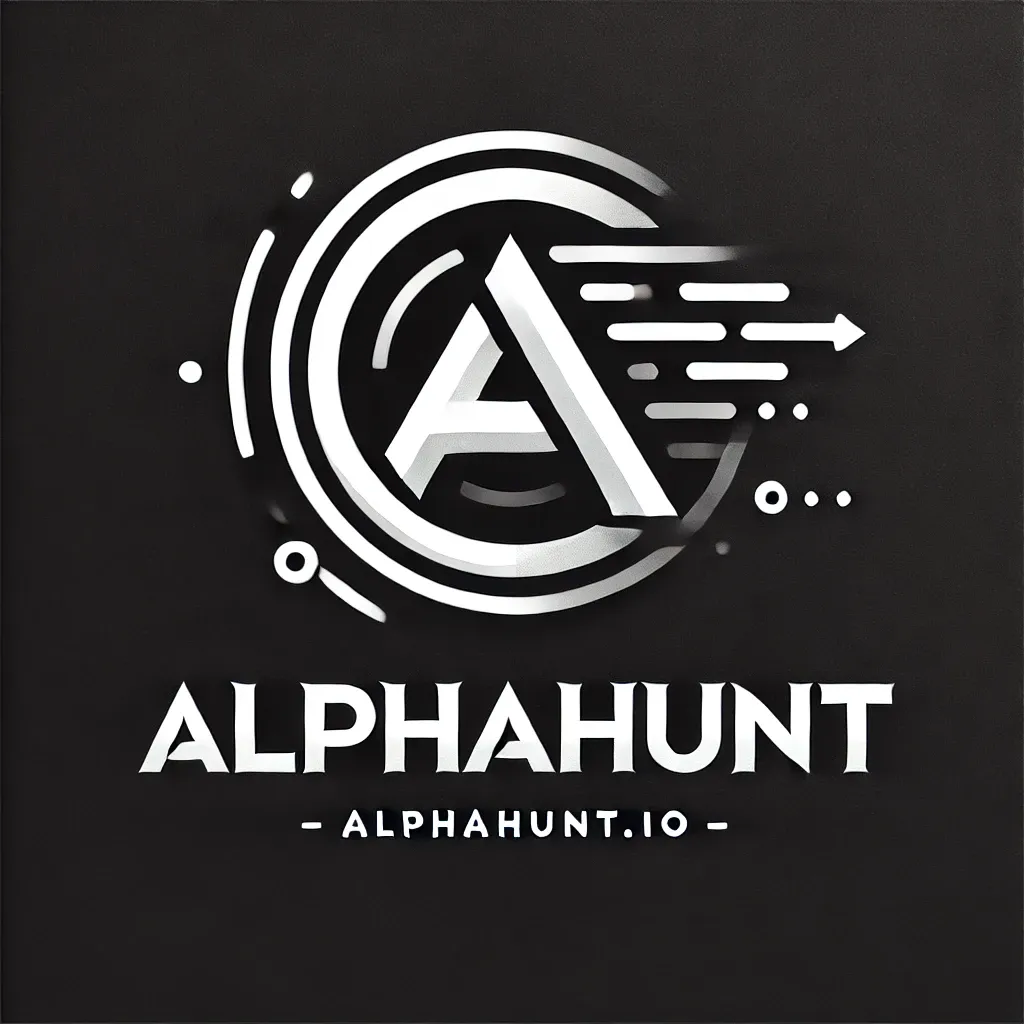Golden Chickens’ Modular MaaS: TerraStealerV2, TerraLogger, and the Evolving Threat to Financial and Recruitment Sectors
Golden Chickens (aka Venom Spider) is a financially motivated Eastern European threat actor operating a modular malware-as-a-service (MaaS) platform since at least 2017..



thanks for all the ... eggs?
(Have feedback? Did something resonate with you? Did something annoy you? Just hit reply! :))
Get questions like this:
- what do you know about venom spider (golden chickens)?
- What are the known affiliations or overlaps between Golden Chickens and other financially motivated threat groups like FIN6 and Cobalt Group in terms of shared infrastructure or malware?
- What are the unique TTPs Golden Chickens employs that differentiate it from other MaaS providers, and how can these be leveraged for attribution and defense?
Does it take a chunks out of your day? Would you like help with the research?
This baseline report was thoughtfully researched and took 10 minutes.. It's meant to be a rough draft for you to enhance with the unique insights that make you an invaluable analyst.
We just did the initial grunt work..
Are you ready to level up your skillset? Get Started Here!
Did this help you? Forward it to a friend!
Suggested Pivot
How does the shared use of Golden Chickens' MaaS platform by groups like FIN6 and Cobalt Group complicate attribution efforts, and what are the implications for identifying and disrupting shared infrastructure and malware code reuse?
TL;DR
Key Points
-
- Golden Chickens (Venom Spider) operates a sophisticated malware-as-a-service (MaaS) platform, supplying modular malware (e.g., More_eggs, TerraStealerV2, TerraLogger, Venom Loader, RevC2) to financially motivated threat actors.
- Their tools are leveraged by groups like FIN6 and Cobalt Group, complicating attribution and expanding operational reach.
-
- Recent campaigns focus on spearphishing with malicious LNK files, targeting recruitment and financial sector employees using fake job offers and resumes.
- These vectors exploit user trust and bypass some email security controls, increasing initial access success rates.
-
- New malware families (TerraStealerV2, TerraLogger) introduce advanced credential theft, keylogging, and evasion techniques, including regsvr32-based OCX execution, XOR obfuscation, and exfiltration via Telegram and custom C2 domains.
- Detection requires updated EDR rules, behavioral analytics, and monitoring for LOLBins and obfuscated network traffic.
-
- Golden Chickens’ MaaS model is likely to evolve, with anticipated expansion into ransomware, AI-driven automation, and more sophisticated data exfiltration modules.
- Enterprises must invest in adaptive security architectures, AI-powered detection, and cross-sector intelligence sharing to counter these threats.
-
- Actionable recommendations include advanced email filtering, targeted user training, EDR and NIPS deployment, automated response playbooks, least privilege enforcement, and continuous threat intelligence integration.
- Regular review and tuning of detection rules, playbooks, and user awareness programs are critical.
Executive Summary
Golden Chickens (aka Venom Spider) is a financially motivated Eastern European threat actor operating a modular malware-as-a-service (MaaS) platform since at least 2017. Their toolkit includes More_eggs, TerraStealerV2, TerraLogger, Venom Loader, and RevC2, which are distributed to other cybercrime groups such as FIN6 and Cobalt Group. The group’s primary attack vector is spearphishing, leveraging malicious Windows shortcut (LNK) files disguised as job offers or resumes to target employees in financial, retail, industrial, and recruitment sectors.
Recent technical developments include the deployment of TerraStealerV2 and TerraLogger, which feature advanced credential theft, keylogging, and evasion capabilities. These malware families utilize regsvr32-based OCX execution, XOR string deobfuscation, and exfiltration via Telegram and custom C2 domains, complicating detection and response. Venom Loader and RevC2 further enhance modular payload delivery, persistence, and multi-faceted espionage through techniques like DLL side-loading and WebSocket-based C2.
Golden Chickens’ operations are characterized by shared infrastructure, overlapping TTPs, and code reuse with other financially motivated groups, making attribution challenging. The group is expected to evolve its MaaS offerings to include ransomware and AI-driven automation, increasing the sophistication and impact of future campaigns.
To mitigate these threats, enterprises should deploy advanced email and endpoint security controls, conduct targeted user training, implement automated response playbooks, enforce least privilege and network segmentation, and integrate continuous threat intelligence. Proactive threat hunting, regular simulation exercises, and participation in industry intelligence sharing groups are essential to stay ahead of Golden Chickens’ evolving tactics.
Attribution
Known Aliases
- Venom Spider
- badbullzvenom
- badbullz
- Lucky (early alias)
- Jack (persona name)
Historical Context
Golden Chickens, also known as Venom Spider, is a financially motivated cybercrime threat actor active since at least 2017. The group operates a sophisticated malware-as-a-service (MaaS) platform, providing modular malware families such as TerraStealer, TerraLoader, More_eggs backdoor, RevC2, and Venom Loader. Their operations have targeted financial institutions, retail, industrial services, hospitality, and other sectors globally. The group is known for leveraging social engineering tactics, including spearphishing with fake job offers and malicious Windows shortcut files (LNK), to gain initial access. The operator behind the group is believed to be individuals from Moldova and Montreal, Canada.
Timeline
- 2017: More_eggs backdoor first observed targeting Russian businesses, including financial institutions.
- 2018: More_eggs JavaScript backdoor attributed to operator "badbullzvenom" (aka Jack) from Moldova.
- 2019: IBM X-Force IRIS reports More_eggs targeting multinational organizations via LinkedIn and email lures.
- 2022-2024: Emergence of new malware families TerraStealerV2, TerraLogger, RevC2, and Venom Loader.
- 2024-2025: Campaigns using fake job applicant lures continue, targeting recruiters and financial sector employees.
Origin
Golden Chickens is attributed to cybercriminal operators based in Eastern Europe, specifically Moldova and Montreal, Canada. The group is known for developing and operating a MaaS platform that supplies malware tools to other financially motivated threat actors.
Countries Targeted
- United States – Large financial and retail sectors targeted.
- United Kingdom – High-profile attacks on British Airways, Ticketmaster UK.
- Russia – Early targets including financial institutions and mining firms.
- Canada – Targeted in campaigns, possibly due to operator location.
- Other multinational organizations – Various sectors globally.
Sectors Targeted
- Financial Institutions – Primary targets for theft and fraud.
- Retail – Targeted for payment data and financial gain.
- Industrial Services – Targeted via spearphishing campaigns.
- Hospitality – Victims include organizations in this sector.
- Technology and Engineering – Targeted roles related to hiring and sales engineering.
Motivation
Golden Chickens is financially motivated, operating a MaaS platform enabling multiple cybercrime groups to conduct financially driven attacks such as credential theft, ransomware deployment, and data exfiltration.
Attack Types
- Spearphishing with social engineering lures (fake job offers, fake resumes)
- Malware distribution via malicious Windows shortcut files (LNK), ZIP archives, and obfuscated scripts
- Use of modular malware families including More_eggs backdoor, TerraStealer, TerraLoader, RevC2, and Venom Loader
- Command and control communication using HTTP/S with obfuscation
- Persistence via registry modifications and use of legitimate Windows utilities (LOLBins) for defense evasion
- Credential theft, keylogging, remote code execution, and network proxying
Breaches Involving This Threat Actor
No specific public breach disclosures directly attributed to Golden Chickens were found in the last year. However, their malware has been linked to campaigns targeting high-value organizations in financial, retail, and industrial sectors. Their malware is used by other financially motivated groups like FIN6 and Cobalt Group, which have been involved in significant breaches.
Links to Other APT Groups
- FIN6: A Russia-based financially motivated cybercrime group known for targeting financial institutions and enterprises. FIN6 uses Golden Chickens' MaaS tools, including the More_eggs backdoor, in spearphishing campaigns targeting recruiters with fake job applications. Shared TTPs include use of malicious LNK files, social engineering, and modular malware.
- Cobalt Group: Another Russia-based financially motivated group leveraging Golden Chickens' malware, including More_eggs, in operations targeting financial institutions. Shared infrastructure and malware code overlaps have been observed.
- Evilnum: Eastern European cybercrime group linked to Golden Chickens' malware, involved in espionage and financial theft, also using similar malware tools and delivery methods.
Similar Threat Actor Groups
- ClickFix: Shares overlapping tactics with Golden Chickens, including use of LNK files and social engineering.
- SideCopy: Pakistani financially motivated threat actor with similar phishing and malware distribution tactics, including overlaps with Golden Chickens' VenomLNK malware.
Technical Evidence of Affiliations
- Shared use of the More_eggs JScript backdoor by Golden Chickens, FIN6, and Cobalt Group
- Overlapping TTPs such as spearphishing with malicious LNK files disguised as resumes or job offers
- Shared infrastructure including command and control servers and malware loaders like TerraLoader
- Malware code overlaps and reuse of modular malware components across campaigns attributed to these groups
- Attribution to the same operator "badbullzvenom" (aka Jack) who developed More_eggs and related malware tools used by FIN6 and Cobalt Group
MITRE ATT&CK Techniques and TTPs
- T1566.001 – Spearphishing Attachment (Malicious LNK files)
- T1204.002 – User Execution: Malicious File
- T1059.005 – Command and Scripting Interpreter: Visual Basic / JScript
- T1071.001 – Application Layer Protocol: Web Protocols (C2 communication)
- T1543.003 – Create or Modify System Process (Persistence via registry)
- T1047 – Windows Management Instrumentation (Execution and discovery)
- T1112 – Modify Registry
- T1027 – Obfuscated Files or Information (Defense evasion)
- T1055 – Process Injection (Observed in some malware variants)
- T1083 – File and Directory Discovery
- T1005 – Data from Local System (Credential theft)
- T1113 – Screen Capture
- T1056.001 – Input Capture: Keylogging
- T1070.004 – Indicator Removal on Host: File Deletion
- T1499 – Endpoint Denial of Service (Ransomware deployment)
Actionable Recommendations
-
Email Security and User Awareness
- Deploy advanced email filtering to detect spearphishing with malicious LNK attachments.
- Conduct targeted user training on recognizing social engineering tactics, especially fake job offers and resumes.
-
Endpoint Detection and Response (EDR)
- Implement EDR solutions with detection rules for obfuscated scripts, malicious LNK files, and suspicious use of Windows utilities (e.g., ie4uinit.exe, regsvr32.exe).
- Example Sigma rule snippet for detecting suspicious LNK execution:
title: Suspicious LNK File Execution id: 12345678-90ab-cdef-1234-567890abcdef status: experimental description: Detects execution of LNK files with obfuscated commands detection: selection: Image|endswith: '\cmd.exe' CommandLine|contains: '.lnk' condition: selection
- Use YARA rules to detect More_eggs backdoor samples based on known strings and obfuscation patterns.
-
Network Monitoring and Intrusion Prevention
- Monitor and block known C2 domains and IPs associated with Golden Chickens and affiliated groups.
- Deploy network intrusion prevention systems (NIPS) to detect and disrupt C2 traffic.
-
Automated Response Playbooks
- Use platforms like Trend Micro Vision One to automate detection and response workflows, including endpoint isolation and IOC blocking.
-
Least Privilege and Network Segmentation
- Enforce least privilege access controls and segment networks to limit lateral movement.
-
Patch Management
- Maintain up-to-date systems and software to reduce exploitation risk.
-
Threat Intelligence Integration
- Subscribe to reputable threat intelligence feeds for timely updates on TTPs, IOCs, and emerging malware variants.
Forward-Looking Analysis
Golden Chickens' MaaS model is likely to evolve in response to increased law enforcement pressure and cybersecurity defenses. Anticipated trends include:
- Development of more sophisticated malware variants with enhanced evasion capabilities
- Expansion of MaaS offerings to include ransomware and data exfiltration modules
- Increased collaboration with other financially motivated groups, potentially blurring attribution further
- Use of more convincing social engineering lures leveraging current events and industry-specific themes
- Greater automation in attack delivery and response evasion, requiring enterprises to adopt AI-driven detection and response solutions
Enterprises should prepare for these developments by investing in adaptive security architectures, continuous threat hunting, and cross-industry intelligence sharing.
Recommendations, Actions, Suggested Pivots, Forecasts and Next Steps..
(Subscribers Only)


![[DEEP RESEARCH] Zero-Days Are a Distraction: 2025’s Biggest Losses Were Stolen Tokens + OAuth](/content/images/size/w600/2025/12/zz-3.png)


